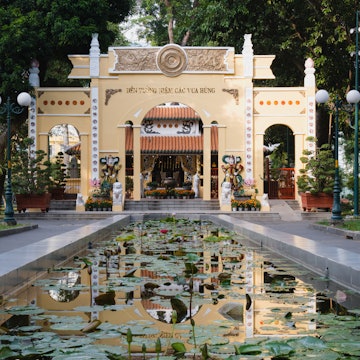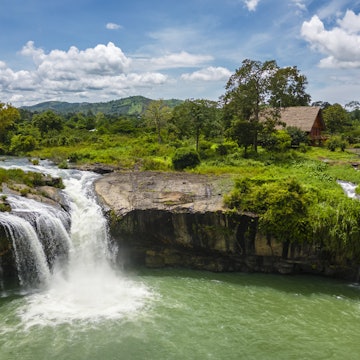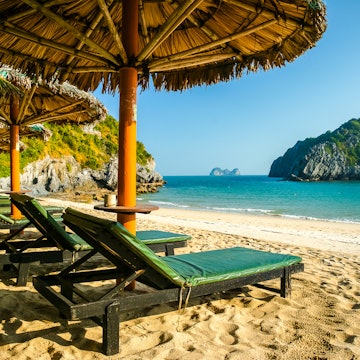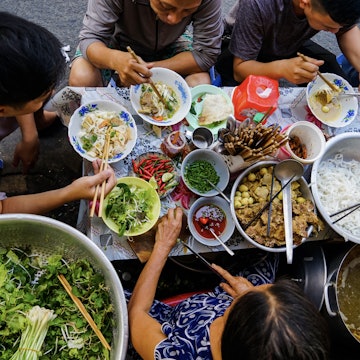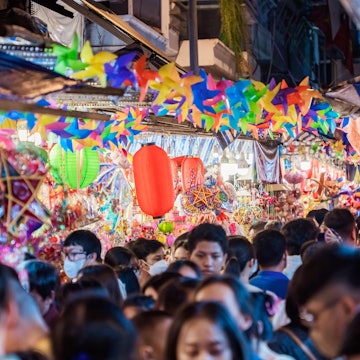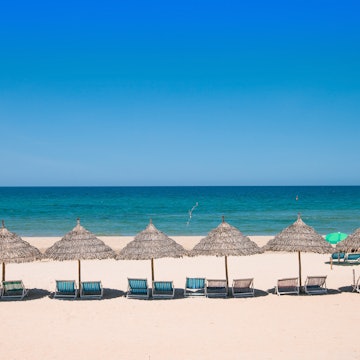

Fishing boats, Quy Nhon. Nguyen Duc Hieu/Shutterstock
With a glittering modern skyline and a kilometers-long beach separated only by a sleek new promenade, Quy Nhon is fast becoming Vietnam’s coastal highlight. Unlike many of the country’s better-known seaside cities, it remains refreshingly authentic, offering abundant seafood feasts, pristine beaches, and the comforts of a modern city without the crowds. A short ride out of the center brings you to traditional fishing villages and hidden coves, while traces of the region’s rich Cham heritage appear across the landscape.
Located roughly halfway between Da Nang and Nha Trang, Quy Nhon is easy to reach by flight or train, making it a natural stop for those exploring Vietnam’s long shoreline. Development is moving quickly and domestic tourists are already catching on, but for now it remains off the main tourist trail.
Here’s everything you need to know to plan your first visit to Quy Nhon.

When should I go to Quy Nhon?
Quy Nhon enjoys pleasant weather year-round, but the best time to visit is from December to April, when daytime temperatures range from 22°C to 28°C (72°F to 82°F). These months bring plenty of sunshine, comfortable conditions, and little rain, perfect for sightseeing or beach days.
It’s best to avoid traveling during Tet (Lunar New Year), Vietnam’s biggest holiday, usually in late January or early February. The holiday lasts about a week, and many shops and restaurants close while transportation options are limited.
The city is busiest from June to August, when domestic tourists, especially large tour groups, flock to beaches. Expect crowded spots, higher accommodation prices, and hot weather with highs around 30°C to 34°C (86°F to 93°F) and occasional showers.
From September to November, the rainy season sets in, making it the quietest and cheapest time to visit. While Quy Nhon itself isn’t usually hit by typhoons, it can still experience heavy rainfall from Central Vietnam’s storms.

How much time should I spend in Quy Nhon?
You’ll need at least two days to see Quy Nhon’s main attractions and enjoy the city at a relaxed pace. Spend time on the beach, wander through local food markets, and visit the ancient Cham towers scattered around the city.
With three days or more, you can venture into the countryside to fishing villages like Nhon Hai and Xuan Hai, or pair a morning at Ky Co Beach with an afternoon walk along the dramatic cliffs of Eo Gio.

Is it easy to get in and around Quy Nhon?
Phu Cat Airport, 31km north of the city, has daily flights from Hanoi and Ho Chi Minh City, with taxis waiting outside for the ride into town. Quy Nhon is also served by Dieu Tri Railway Station, 10km west of the center, on the north–south Reunification Express that links cities such as Da Nang and Nha Trang. (Quy Nhon’s small city station is not connected to this line.) From nearby destinations like Tuy Hoa and Quang Ngai, frequent buses and minivans are also available.
Quy Nhon’s city center is compact and easy to navigate on foot, with most hotels, restaurants, and shops clustered along the seaside promenade. Taxis and rideshares are also easy to find in the center. For longer distances, motorbike rentals are widely available and are the most convenient option. If you’re not comfortable riding a motorbike, you can hire a car and driver for day trips to the countryside and coastal villages.

Top things to do in Quy Nhon
See the Cham Towers
Binh Dinh was once the heartland of the Champa Kingdom, which flourished along Vietnam’s central coast from the 2nd to the 15th century. The Cham were renowned for their mastery of brickwork, a skill still evident today in the striking towers scattered around Quy Nhon. Right in the city center, the Thap Doi Cham Towers are beautifully preserved and easy to visit, while just outside town, the Banh It Towers rise from a hilltop, offering sweeping views over the countryside.
A short walk from the seaside promenade, the Binh Dinh Museum houses galleries that display intricately carved sculptures, ceremonial objects, and other relics that provide a deeper look at Cham culture.
Stroll along the promenade
Quy Nhon’s centerpiece is its 5km-long beachfront promenade, running parallel to the golden curve of Quy Nhon Beach. As the sun begins to set, the promenade comes alive: locals gather for evening walks, impromptu games of volleyball break out on the sand, and families cool off by the water. For dinner, head to Ngo Van So St, where sizzling food stalls serve up everything from fresh seafood to local specialties like nem nuong (grilled pork rolls). End the night at Surf Bar with a cold beer right on the beach.

Relax on the region's pristine beaches
Quy Nhon is home to some of Vietnam’s most beautiful stretches of sand, many of them still blissfully under the radar. The exception is Ky Co Beach, a hidden cove reached by a short 4WD ride or boat tour. Its turquoise waters and white sand are breathtaking, but the secret is long out, and it now draws plenty of domestic visitors.
For a quieter escape, head north to The Thon Beach, an undeveloped stretch where you’ll likely have the shoreline almost entirely to yourself. If you’d rather pair your swim with a good meal, venture south to Bai Xep. Here, Haven Restaurant sits in a small bay shared with luxury resorts, but a public strip of crystal-clear water remains perfect for a refreshing dip.
Feast on fresh seafood
Quy Nhon is a paradise for seafood lovers, where the ocean’s bounty arrives straight from the boats to your plate. Stroll along Xuan Dieu St and you’ll find dozens of restaurants serving everything from fish to grilled crabs, while street stalls steam plates ofoc (snails), a local favorite. For the adventurous palate, don’t miss the jellyfish noodles, with each bite offering a surprising crunch.
For a more scenic feast, head south to Bai Xep Beach, where as the sun begins to set, the shoreline transforms into an open-air dining area. Buckets brimming with the day’s catch are proudly displayed, and each dish is prepared to order.
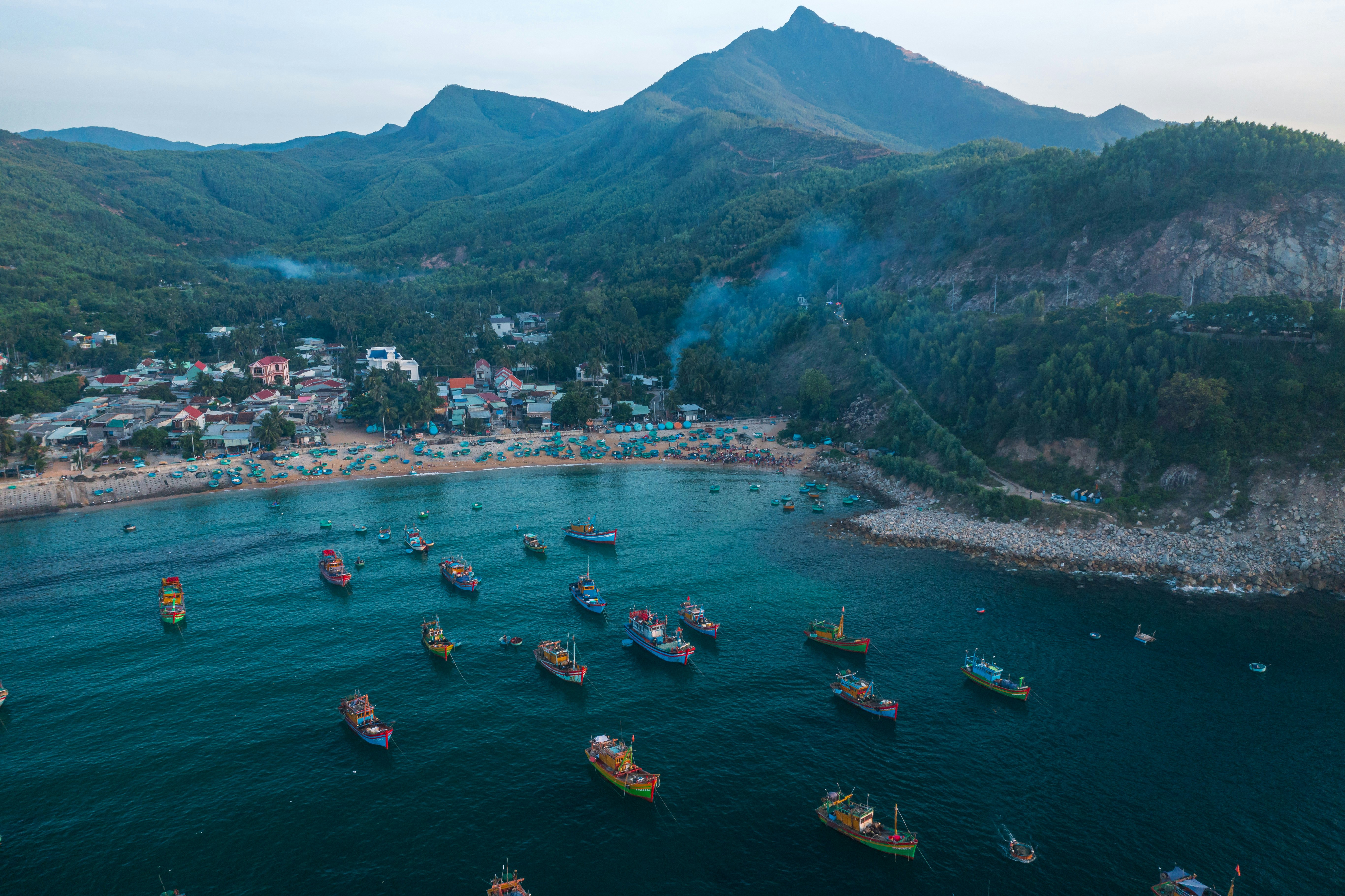
My favorite thing to do in Quy Nhon
I love many things about Quy Nhon, but most of all, I enjoy hopping on a motorbike and cruising along its coastal roads, discovering the small fishing villages tucked along the shore.
Just south of Quy Nhon, Xuan Hai fishing village comes alive every morning as hundreds of boats return to shore. The lively scene of fishers unloading their catch and vendors selling buckets of fish right on the sand makes it one of the most fascinating markets I’ve seen in Vietnam. If the market feels overwhelming, escape to Cafe Bai Ran (the View Coffee), perched on a nearby cliff, and enjoy the rest of your morning with sweeping views of the sea dotted with colorful boats.
About 17km east of the city, Nhon Hai fishing village sits in a picturesque cove backed by verdant mountains. Stroll through the narrow lanes winding between the houses, and be sure to stop for some sizzling banh xeo muc (squid pancakes), a local breakfast delicacy you won’t want to miss. If you visit in June, rent a paddleboard and glide over the glistening waters, with fields of golden seaweed shimmering beneath you.
Nearby, the village of Nhon Ly charms with its small fishing port to the south and Santorini-inspired cafes tucked into narrow, whitewashed alleyways to the north. From here, a short walk brings you to the coastal path of Eo Gio, which hugs the rugged cliffs and is especially stunning at sunrise or sunset.

How much money do I need for Quy Nhon?
Quy Nhon is an affordable destination with plenty of options for every budget. Like elsewhere in Vietnam, cash is still king, so it’s wise to keep small bills on hand. ATMs are plentiful in the city center, and most hotels and larger restaurants also accept international credit cards.
Taxi from the airport to the city center: 300,000d (US$11)
Car hire for the day: 2,000,000d (US$75)
Motorbike rental per day: 150,000d (US$5.70)
Basic room for two: 1,200,000d (US$45)
Dorm bed: 150,000d (US$5.70)
Seafood meal at a local restaurant: 250,000d (US$9.50)
Beer/pint at a beach bar: 32,000d (US$1.20)
Where is the best area to stay in Quy Nhon?
The most popular option is a seaside hotel along the promenade, offering convenience and ocean views, though prices can be slightly higher. Just a few blocks inland, you’ll find equally comfortable hotels at more reasonable rates. Le Mint Hotel stands out for its excellent value, featuring a rooftop pool, complimentary buffet breakfast, and free bicycle rentals for guests.
For something different, consider staying in Bai Xep, where luxury resorts come with private stretches of beach. If you want to experience local hospitality, Confetti Guesthouse (also Pon’s Kitchen) offers cozy rooms paired with fantastic homemade meals.









